Leg weakness in the elderly is a huge problem and a major cause of loss of independence. In this article I'll explain
- The various causes of leg weakness in the elderly
- How to prevent it and how to overcome it.
Last updated May 2o24
What causes leg weakness in the elderly?
Leg weakness in the elderly is a complex issue. It's not just one factor that causes leg weakness. Several factors all play a role in the gradual weakening that so many elderly people experience.
However, scientists have done a great job at teasing out and identifying these factors which means effective solutions can be implemented to really help prevent muscle weakness from happening in the elderly.
One of the biggest issues society faces is getting this good quality information out to the masses as well as helping older adults and the elderly to actually do what's required to help prevent leg weakness occurring.
Weakness isn't just happening in the lower extremity of the body in seniors, but the upper body as well. Without the specific interventions I'll go on to talk about in this article the ageing process will ultimately lead to weakness. Just remember, it doesn't have to.
At the moment, this isn't happening on a large scale. And because of society's increased lifespan, we're seeing more and more elderly people really struggling with leg weakness and other mobility struggles.
Elderly people are having to rely on support from loved ones more and more as well as having to pay out large sums for assisted living and home care.
Let's discuss some of the key causes of leg weakness in the elderly population.
Sarcopenia
The chances are that you've heard of Sarcopenia before or you may even have been told you have it. Sarcopenia is pretty complex syndrome that can effect people very differently with very different levels of severity.
Sarcopenia is an age related syndrome that causes mild to very severe muscle loss, muscle strength and muscle function.
Sarcopenia has been further categorised into "pre" sarcopenia and "severe" sarcopenia.
Pre sarcopenia refers to loss of just muscle mass whilst severe sarcopenia is associated with loss of muscle mass, strength and function.
There isn't necessarily a direct correlation between loss of muscle mass and loss of strength. Some people can experience loss of muscle mass whilst retaining similar levels of their strength.
It's widely considered that the entire population will experience sarcopenia to some extent but it's apparent that the older generation are at a far greater risk of sarcopenia than younger people.
There is also a distinct linear curve between age and sarcopenia severity.
However, the earlier you can start to prevent potential sarcopenia the more effectively you will retain muscle mass and strength.
Studies suggest that sarcopenia can cause up to a 50% loss of muscle mass for someone in their 80's. This really helps to explain just why people in the 80's and 90's struggle so much with mobility and general day to day activities.
You can read my more in depth article about Sarcopenia by clicking HERE
Age related muscle loss (that isn't classified as Sarcopenia)
Beyond Sarcopenia there is the issue of simply losing muscle mass with age. Whereas Sarcopenia generally describes an accelerated rate of muscle decline, age related loss of muscle mass will happen either way.
Loss of muscle mass generally starts to happen in our 30's and starts to accelerate in our 40's.
Most of you reading this who are suffering with leg muscle weakness will likely be in your 70's and 80's. Whilst you might think that your leg weakness has only started to happen it's actually very likely to be as a result of very gradual loss of muscle mass over many years which has just accelerated more recently.
The rate of muscle decline for someone on their 30's and 40's is very slow but it is happening. (Assuming that person isn't employing tactics to prevent muscle loss)
Osteopenia and Osteoporosis
These conditions are related to bone loss and bone fragility.
You've probably heard of an elderly person who took a fall and fractured their hip or leg. It may have even happened to you or a loved one.
General bone loss is associated with ageing but just like Sarcopenia, in some people the progression is much quicker than the average person.
Osteopenia refers to bone loss before it reaches a later stage known as osteoporosis. However those with osteopenia do not always go on to develop osteoporosis.
The conditions often go undiagnosed because there isn't usually any pain associated with bone loss. It's often not until someone suffers a fracture from a fall that their osteoporosis is discovered.
Bone density can be measured via a DEXA scan. Anyone with changes in posture (particularly a stooping posture) is likely to be suffering with osteoporosis and so getting a DEXA scan can give an indication of the severity.
There are some specific risk factors that you should be aware of.
- Women who have gone through menopause. (particularly those who went through an earlier than average menopause.
- Anyone taking certain medications such as steroids or some cancer preventative drugs.
- Genetics
- Heavy smoking/drinking
Just like Sarcopenia and arthritis, osteoporosis can be prevented and treated with better nutrition and strength exercises. It's much better to get ahead of bone loss and prevent it early rather than having a fall and breaking a bone.
This will likely result in more time spent being sedentary meaning even more muscle and bone loss and maybe paying out lots of money for specific physical therapy treatment.
Arthritis
Arthritis is a hugely complex issue that generally affects the elderly population.
There are hundreds of different types of arthritis but it's osteoarthritis that is most prevalent in older adults.
Osteoarthritis can affect any joint but it's most commonly seen in the bigger, weight bearing joints such as the knees, hips and spine. It's also often seen in the hands and fingers.
Although osteoarthritis is disease of the joints and not the muscles it still typically has a significant impact on muscle loss in the elderly.
This is because osteoarthritis generally causes pain and stiffness and a result osteoarthritis sufferers tend to be far less active and far more sedentary.
Sedentary behaviour is a huge risk factor for muscle weakness in the elderly and older adult population.
Poor Nutrition
Nutrition is often a factor in the elderly population losing muscle mass and there are few reasons for this.
Perhaps the most significant is lack of protein in the diet.
Interestingly the majority of all age groups do not consume an optimal amount of protein in their diet.
It doesn't help that the international guidelines for daily protein intake is set a levels far below optimal. The WHO (World Health Organisation) suggests a daily intake of 0.8 grams per kg of bodyweight.
Nutritional scientists suggest that this figure should be somewhere north of 1 gram per kg of bodyweight and even up to 2.2 grams per kg of body weight.
The current recommendation is set to avoid deficiency as opposed to being set for optimal health.
The issue is further exacerbated in the elderly population because of a reduced response to protein building muscle mass. This means that elderly people need even protein in order to over come this blunted response and kickstart the bodies muscle building process.
For more in depth information on protein in relation to elderly and for protein drink and supplement reviews and recommendations check out this article - best protein drink for elderly
Some older adults also struggle with weight loss often due to changes in pallet, reduction in appetite and loss of fine motor skills which hampers their ability to cook.
A weakness in the legs can also prevent the elderly from being able to stand for long periods of time which can also make cooking harder.
Why is leg weakness in the elderly so common?
So I've discussed at length some of the primary causes of why the elderly and older adults suffer with leg weakness but we also need to address why it's so common.
And this is important to understand because ultimately there are ways to prevent leg weakness in the elderly and older adult population.
The huge issue society is facing is that the elderly and older population are NOT doing the things they need to be doing in order to prevent these primary causes of leg weakness (and other muscles)
A big reason for this is because elderly people either don't know what they should be doing or are being advised to do the wrong things. (or at least, things that just aren't that important)
All too often an elderly person will be given an obscure supplement with the promise it will help keep them strong.
Or they will be advised on a certain type of exercise that simply won't help to grow or even retain muscle mass.
In following sections on both exercise and nutrition I will tell you the most effective things you need to be doing in order to preserve your strength. If you incorporate what I'm about to teach you, you WILL gain strength and reduce your leg muscle weakness.
How can exercise help to prevent leg weakness in the elderly?
It's all very well saying that exercise will help to prevent leg weakness in the elderly and older adult population but the issue is WHICH exercise?
I'd be willing to bet that most older adults don't truly understand how different exercise types affects the body. In fact most of the population in general don't understand. IN FACT... a lot of personal trainers don't understand. How scary is that.
I think it's important to state first of all that pretty much all exercise is healthy. Exercise leads to wise variety health benefits.
But not all exercise is necessarily that helpful for strengthening muscles.
The best form exercise to develop muscle strength is resistance training/weight training.
In fact resistance training is really the only way you can effectively preserve and grow muscle mass.
Do you currently do any form of resistance training or weight training?
I'd be willing to guess, no.
Very very few elderly people or older adults take part in resistance training.
And that's why leg weakness is so incredibly common among the older adult population.
It's actually astonishing that this demographic are largely neglecting the one thing that will help them to remain strong mobile and independent.
But WHY is this happening?
I think it's a combination of things.
- The current paradigm does not align to elderly people doing resistance training.
- There's very little access for elderly people to get involved in resistance training.
- There's very little education around resistance training and elderly people.
What is resistance training?
Let me clarify what resistance training actually is.
You're going to need to know if you want to prevent or overcome your leg weakness.
Resistance training is the same as weight training. But don't be put off just yet.
I'm not necessarily talking about lifting huge dumbbells and barbells above your head or building so much muscle you end up looking like a body builder.
But in order for you muscles to at least stay the same strength or get stronger you absolutely have to incorporate some resistance training into your routine.
Let me me give you quick crash course into how muscles work.
Our muscles pull on our bones to make them move. Essentially our body works like a pulley system. All of the bodies muscles run along our bones and attach themselves at different ends of joints.
For example, take the bicep muscle in the upper arm. The bicep muscle is responsible for making the elbow joint bend. Therefore the bicep muscle has to actually pass the elbow joint in order for it pull in the lower arm bone.
In the image you can see the bicep originates on the scapula and runs all the way down the upper arm bone (humerus), passes the elbow joint and attaches to the lower arm bone (radius). If the muscle didn't pass the elbow joint it wouldn't be able to move the elbow joint.
Exactly the same principles apply in all the muscles in the body.
Without gravity we have no need for muscles. Gravitational pull is the constant force our muscles are working against.
When astronauts go into space they have to spend a large proportion of their time doing resistance training. Outside of this specific exercise their muscles are not required to anything. There is no gravity for the muscles to work against.
If the muscles aren't stimulated very regularly they waste away very quickly.
In order for humans to be able to move effectively on Earth our muscles have to be able to produce a stronger force that gravity does.
Our own bodyweight only provides a limited amount of resistance. In order to become even stronger and to be able to move our bodies around really efficiently within a gravity zone we have to provide our muscles with more load.
For example, holding onto a dumbbell provides added load to our muscles.
We can then further increase the effectiviness of that load by flexing and extending our joints.
When we hold a something heavy in our hands (such as a dumbbell) and then bend the elbow back and fourth the bicep muscle contracts and stretches over an over again.
And it's THIS principle that creates stronger muscles.
Remember I said that because astronauts don't have any gravity to fight against, unless they do special exercises their muscles will waste away. Well this is exactly what happens to so many elderly people.
They become extremely sedentary and sit for the majority of the day. Whilst they're sitting there are not using their muscles at all. Over time their muscles waste away.
And of course this is further exacerbated by things like Sarcopenia.
This pilot study conducted in Berlin took 15 care home residents between 77-94 years old (with a median age of 84) all with mild to severe mobility issues and studied them across 8 weeks doing 2 resistance training sessions per week.
The results of the study showed all the participants significant improvements in mobility and strength. They each did 6 different resistance based exercises and show progression on each one over an 8 week period.
This was a significant finding given the age of participants and the restricted levels of mobility they had to start with.
This study examined the effects of strength training on muscle mass and function in older men. The results demonstrated significant increases in muscle strength and cross-sectional area, indicating that resistance training can effectively combat muscle weakness in the elderly in just 12 weeks.
It goes to show, no matter your age and levels of strength and mobility, they can most likely be significantly improved upon with the right style of training.
The health benefits of resistance training go way beyond increased strength and mobility. It can help manage a array of different health and medical conditions, such a high cholesterol, poor circulation, high blood pressure, heart disease and many many more.
How long will it take to strengthen my legs with resistance exercise?
Not long at all!
Isn't that just great news. Whilst we start to lose muscle mass slowly from around the age of 30 and often see significant loss of muscle mass by around aged 75-80, fortunately it doesn't take long to get it back.
You just need to be doing the correct type of exercise that I talked about above. Resistance training!
You can expect to gain strength and muscle mass in as little as 4-6 weeks. If you resistance training 3 times a week for 6 weeks and make sure you eat enough protein you'll feel like a new person.
Actually doing the resistance training does require effort and it's really helpful to have a professional to guide you along the journey to make sure you're doing everything correctly.
One of the biggest things I see is older adults being given exercises that just don't do enough. I certain level of intensity has to be achieved when doing exercises to ensure your body adapts.
The Wise Fitness Academy monthly home workouts include detailed instructions and walk throughs to ensure you know what you need to be doing.
Hoe effective is walking for strengthening weak legs?
The short answer is - not very.
Hopefully after reading the last section you've got a much better understanding of how muscles work and how they become stronger.
Let's apply some of the principles to walking to see why walking isn't particularly effective at strengthening muscles.
Remember the bicep example I gave about bending the elbow forwards and backwards (flexing and extending).
Well when we walk, the knee joints and hip joint flexes and extends.
The PROBLEM is they're only flexing and extending a small amount. When we walk our knees only bend a little bit.
On top of that, in general there is no added load provided.
This means that walking (without any added load) will only stimulate the leg muscles a little bit.
If you put on a 20 kilo backpack then all of a sudden walking will be become much harder. The load has increased dramatically but the bending of the knee and hips is still limited.
If you put on a 20 kilo backpack and then stepped up onto a chair it would be really difficult.
Because now, not only do you have added load but you're also flexing and extending the knee and hip joints much more. They're moving through a far greater range of motion.
OK, now add one more thing. With the 20 kilo backpack on, step up onto the chair and then back down. Then repeat the movement 10 times.
And voila - you are now doing highly effective resistance training.
It IS important to recognise that whilst walking isn't the best option for building strength, it's still INCREDIBLY healthy and will have a significant affect on so many other health markers.
How can nutrition help to overcome leg weakness in the elderly?
Protein
I already a lot about protein being a fundamental dietary requirement for gaining muscle and strength earlier in this article.
Let me reiterate it's important very quickly.
The elderly and older adult population need more protein than their younger counterparts because of a blunted response to how protein makes muscle.
The current guidelines set at 0.8 grams per kilo of body weight are way too low. You should aim for between 1.6-2.0 grams per kilo of bodyweight. You should also split those feedings up up across your day having no less that 25 grams per serving.
I cannot emphasise enough just how important protein is for retaining and growing muscle mass and strength.
Overall Calorie intake
The second most important nutritional consideration for gaining and preserving muscle strength is your overall Calorie intake.
It's uncommon for elderly people to struggle with maintaining their weight. This can be due to a combination of factors such as loss of appetite, inability to cook and denture problems.
If you eat fewer Calories than you expend then you are in what's known as a Calorie deficit and will ultimately lose weight. In order for your muscles to grow or at least be preserved you ideally need to be eating more Calories than you expending.
There are lots of ways for the elderly to consume more Calories without having necessarily cook meals.
Liquid Calories are a great option as they are easy to make and consume. There is a range of nourishment drinks that can purchased pre-made. These can be a great way for the elderly to easily get more Calories into their diet.
General nutrition
Maintaining general nutritional health is always going to have a positive impact on helping you to stay fit and well. Beyond the more specific things such as protein intake, it's important to remember the the core pillars of good nutritional health. Eating a balanced diet will ensure you get all the essential vitamins and minerals along with other vital nutrients you need.
- Eating fruit and vegetables daily
- Eating enough fibre (~30 grams per day)
- Eating whole grains
- Eating lean meats and fish
- Eating health fats (nuts, avocados)
- Drinking enough water
- Limiting saturated fat
- Limiting highly processed foods
- limiting alcohol consumption
What are the best exercises to prevent leg weakness in the elderly?
By now hopefully you're fully clued up about the importance of protein and resistance training for increase strength and mobility.
These 2 things are an absolute game changing combination that should be advertised to the entire older adult population.
Governments should be putting money behind a campaign that advertises these 2 things.
I'll give you 3 great exercises that will be extremely helpful for preventing leg weakness or indeed helping to build strength back up in your legs.
Squats
Squatting is just about the most primitive and common movement pattern than humans do.
You see this cute toddler below
She's sat in a squat.
It's one of the most common positions a young person will adopt.
Most adults cannot sit into a squat this deep, let alone older adults.
Being able to squat comfortably is a key sign of having a good level of strength and flexibility.
Now I'm not suggesting that as an elderly person who probably has weak legs you need to be squatting like the child pictured above.
However, you should work to be able to squat to a sitting position. And that's VERY achievable.
A sitting to standing challenge is a very common way for trainers and physiotherapists to gauge a clients level of fitness and mobility.
Grab a chair and repeatedly sit down and stand back up slowly (ideally without using your arms)
If you can comfortably do 10 repetitions I'd suggest you're doing pretty well. Don't worry of you can't though, you can build the strength over time.
Checkout the below instructional on how to do squats.
Glute bridges
The glute muscles are the biggest in the body. They surround your entire bum area and are responsible for some key movements including flexing and extending the hips.
The glutes are commonly overlooked when it comes to exercise. And this is the case for younger people as well. A lot of imbalances and pain comes from having weak glutes.
Glute bridges are a fantastic "low impact" exercise that will help to strengthen them over time. By "low impact" I mean that the exercise doesn't put much pressure on the joints. This means that most people, even people with arthritis should be able to perform them comfortable.
They do require you to be able to get into a lying down position. So depending on your current levels of mobility make sure you have supports (such as a chair or a stick) near by to hold onto if you need to.
Lunges
Lunges are a single leg exercise meaning you exercise one leg at a time during the movement. They can be great for evening out strength imbalances in the legs.
For this exercise I recommend having a support (such as a chair) to aid with balance when performing the exercise.
Conclusion
I will conclude this article with a list of key points.
- Leg weakness in the elderly is extremely common but NOT inevitable.
- As it stands, society does a terrible job at effectively teaching elderly people how to prevent or overcome leg weakness
- Leg weakness in the elderly can be as a result of many factors which are often combined to further exacerbate the issue.
- Some of the more common issues that leads to leg weakness in the elderly is Sarcopenia, osteoporosis, age related muscle loss, sedentary lifestyle, lack of protein in the diet and lack of overall Calories in the diet.
- 2 extremely effective ways to overcome and prevent leg weakness is regular resistance training and a focus on optimal protein intake.
Author: Ollie Laver
Qualifications: Certified level 3 Personal Trainer and MNU certified nutritionist.
Come and join our Facebook community group by clicking here.
Leg weakness in the elderly - FAQ
Cycling is pretty good for helping to preserve strength in the lower body but it won't be as effective as progressive resistance training programme.
Cycling does other great benefits as well.
It's low impact meaning it won't tax the joint too much.
It's also great for cardiovascular health.
No, but weights are specifically designed to be lifted.
You know the saying "use the right tool for the job"
Well it applies nicely here.
Weights are NOT just for young gym goers who are trying to get muscly.
Also, weights can be used at home very effectively.
There are other great bits of resistance training equipment such as resistance bands, medicine balls, TRX straps and swiss balls.
Yes absolutely.
All the the Wise Fitness Academy resistance workouts are home based.
If this has had a sudden onset without an obvious reason as to why (such as a hospital stay or bout of illness) then you should speak to your doctor.
Weakness that has developed overtime is likely due to gradual loss of muscle mass and strength due to ageing and it's associated conditions and syndromes that are discussed in the main article.
Sources
- Strength conditioning in older men: skeletal muscle hypertrophy and improved function;
W R Frontera 1, C N Meredith, K P O'Reilly, H G Knuttgen, W J Evans - Can progressive resistance training twice a week improve mobility, muscle strength, and quality of life in very elderly nursing-home residents with impaired mobility? A pilot study; Lilian Krist, Fernando Dimeo, and Thomas Keil1,
Influences:
- Dr. William Evans - pioneering researcher into muscle loss in the elderly. You can see a great podcast featuring Dr Evans here


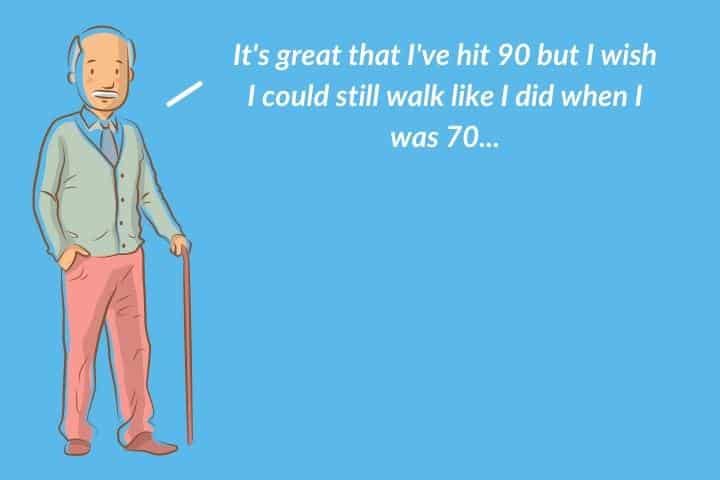

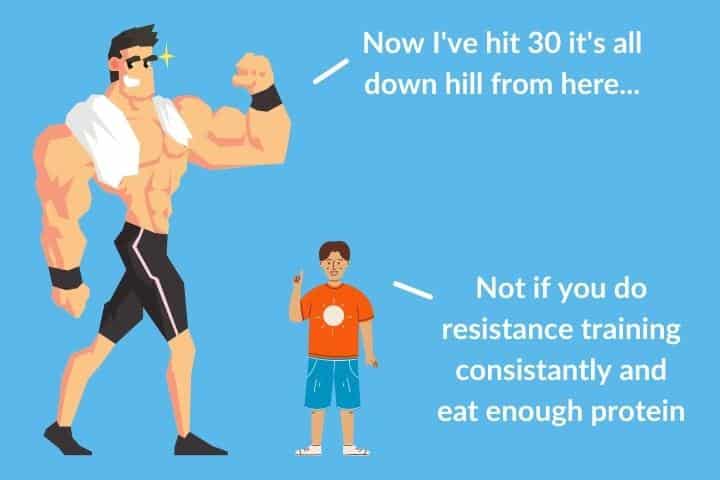
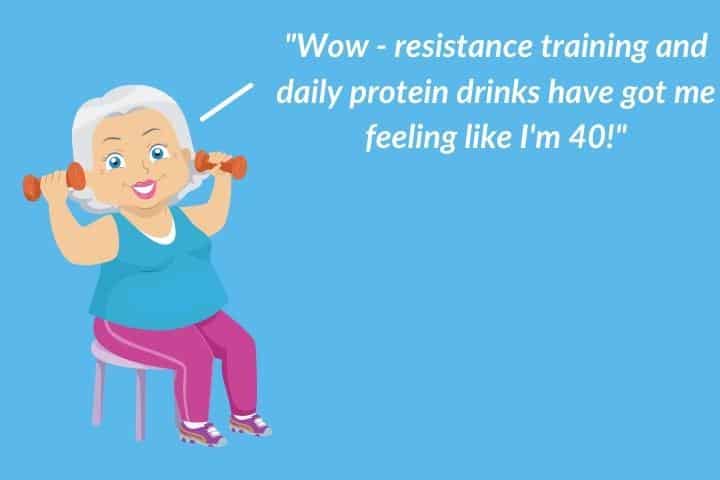
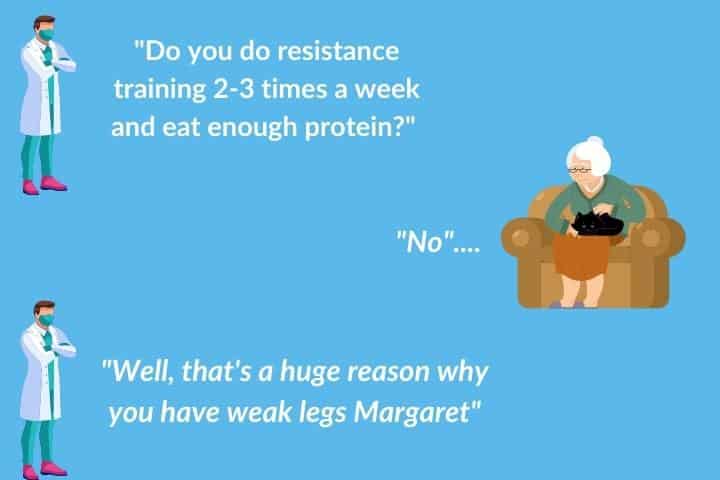
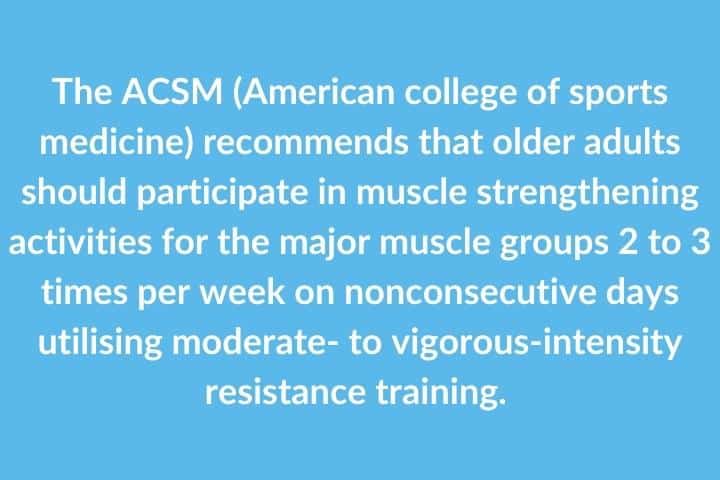
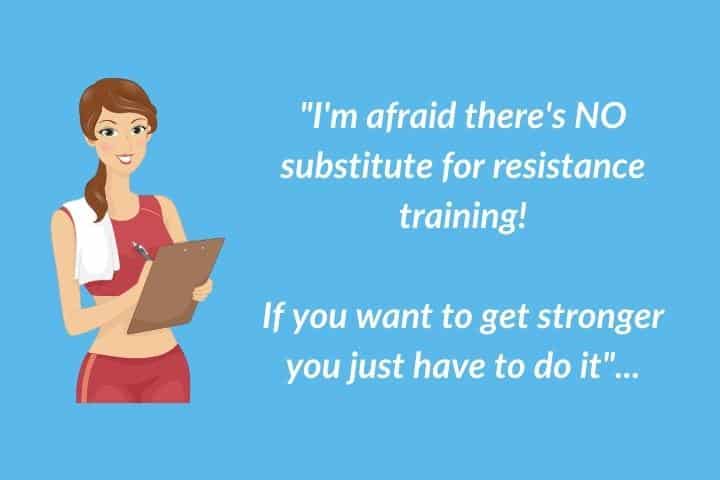
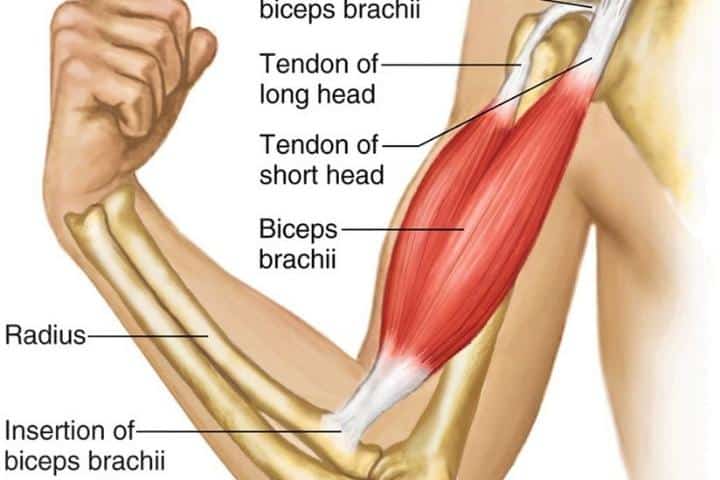

[…] Leg weakness in the elderly […]